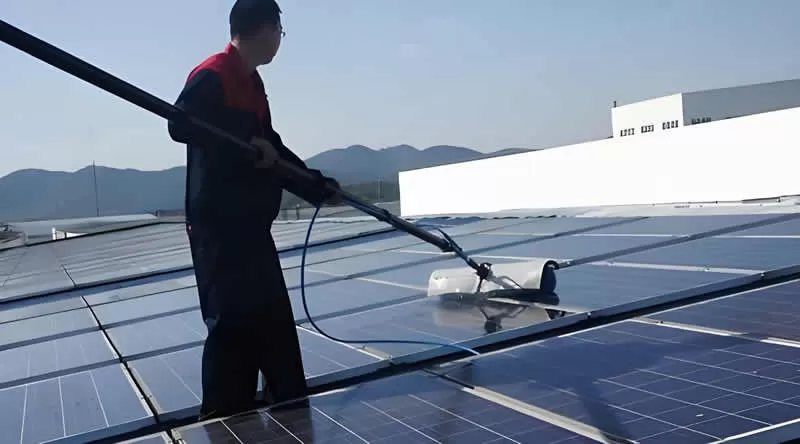
Inspection and maintenance of solar photovoltaic equipment
In recent years, the global solar photovoltaic industry has entered a phase of rapid growth. According to the International Energy Agency (IEA) statistics, in 2023 the global PV new installed capacity exceeded 350 GW, China, Europe and the United States dominate the market. As the proportion of photovoltaic power generation increases, the importance of energy storage battery as a supporting equipment is increasingly prominent, its core role is to solve the intermittent problem of photovoltaic power generation, to realize the “peak shaving to fill the valley” and grid frequency regulation. It is expected that by 2030, the global energy storage battery market size will exceed 500 billion U.S. dollars.
Solar photovoltaic storage battery as a photovoltaic system in one of the key components, carrying the task of storing and releasing solar energy, to ensure that the home or business can still get a stable power supply when the sunshine is not enough. In order to ensure that the energy storage battery operates efficiently for a long time and prolongs its service life, scientific maintenance is crucial. Here are some tips on how to maintain solar storage batteries and how to extend their life.
1. Factors affecting the life of energy storage batteries
Battery types commonly used in solar photovoltaic energy storage systems include lithium iron phosphate (LFP), lithium ternary batteries (NCM/NCA) and lead-acid batteries, whose theoretical cycle life is as follows, respectively:
Lithium iron phosphate battery: 3000-6000 times (80% capacity retention rate)
Li-ion ternary battery: 1500-2500 times
Lead-acid battery: 500-1200 times
The actual service life is affected by multiple factors such as depth of charge/discharge (DoD), temperature and environment, and equalization management. For example, lithium iron phosphate battery in 25 ℃ environment, 50% DoD conditions, the service life can be extended by 3 times than full charge and discharge.
2. Battery Maintenance Strategy
Intelligent charge/discharge management
Dynamic threshold control is adopted to set the SOC (State of Charge) to operate in the range of 20%-90% to avoid deep discharge (<10%) and overcharge (>95%). Equipped with an adaptive BMS system that automatically optimizes the charging and discharging curves based on historical charging and discharging data, such as activating the gradient discharging mode on cloudy and rainy days.
Thermal management technology innovation
Build a hierarchical temperature control system, adopting phase change material (PCM) + liquid cooling hybrid heat dissipation in summer, and activating electric heating film heat preservation in winter. Keeping the working temperature in the golden zone of 15-35℃, every 10℃ rise in temperature accelerates the rate of battery life decay by 2 times.
Battery health diagnosis system
Utilizing monthly internal resistance testing, using HIOKI BT3562 and other professional equipment to monitor the battery internal resistance changes, internal resistance increase of more than 20% need to be warned. Quarterly capacity calibration, reconstructing the SOC-OCV curve through 0.2C charge/discharge cycles, and correcting BMS parameter deviations.
Cloud Collaborative Maintenance
Deploy digital twin system to simulate the battery aging process through real-time data mirroring, predicting the inflection point of capacity degradation 6 months in advance. Applying AI life prediction model, fusing 20+ parameters such as cycle times, temperature distribution, charge/discharge multiplier, etc., the life prediction accuracy reaches 92%.
Comprehensively these battery life factors and strategies, the next section introduces the suggestions to extend battery life from multiple aspects.

Cleaning of solar panels
3. Maintain a suitable temperature environment
Solar photovoltaic energy storage batteries usually have strict requirements for their operating temperature range. Excessively high or low temperatures can lead to degradation of battery performance and even shortened service life. The ideal operating temperature for most solar storage batteries is between 15°C and 25°C. If the ambient temperature is too high, the chemical reaction inside the battery speeds up, which may lead to accelerated aging of the battery; while low temperatures may lead to reduced battery efficiency and reduced storage capacity.
Suggestion: When installing the battery, try to choose a well-ventilated area and avoid direct sunlight. Use protective cover or heat insulation to maintain the temperature stability of the battery, especially in extreme climatic conditions.
4. Avoid deep discharge
Deep discharge (i.e., discharging the battery to a very low state) of the energy storage battery will cause greater damage to the internal structure of the battery and reduce its service life. Therefore, it is very important to keep the battery working within a certain power range.
Suggestion: Avoid discharging the battery to 0%, most batteries work best in the 20% to 80% charge range. Use a Battery Management System (BMS) with automatic protection to stop discharging automatically when the charge level is too low.
5. Clean the battery and connecting parts regularly
Accumulation of dust or dirt on the exterior of the battery and the connection ports may affect the effectiveness of the battery's heat dissipation, thereby increasing the risk of overheating. Regular cleaning of the battery's surface and connection ports will help improve its efficiency and prevent malfunctions.
Recommendation: Use a clean, soft cloth to gently wipe the battery surface, avoiding the use of strong corrosive cleaners. Check the battery connection ports to ensure that the connectors are not rusted or loose to prevent loss of current or battery failure.
6. Check battery performance regularly
Regularly checking the charging and discharging performance of solar storage batteries can detect potential problems in advance. By monitoring the battery's parameters such as voltage, current and temperature, you can ensure that the battery is working in the best condition.
Recommendation: Use a Battery Management System (BMS) to monitor the battery status in real time and get timely information about the battery's health. Perform regular professional maintenance checks, especially within one year after the initial installation of the system, to ensure that the battery is not abnormally aged or damaged.
7. Avoid prolonged full or empty state
Energy storage batteries that are fully charged or completely discharged for long periods of time are prone to deterioration of the battery's electrochemical performance. Especially in the case of prolonged deactivation, keeping the battery between 40% and 60% helps to maintain its healthy state.
Recommendation: If you don't plan to use your solar storage battery for an extended period of time, make sure that the battery is kept at a moderate level of charge and that it is charged and discharged at regular intervals. In winter or when not in use for a long time, check the status of the battery and make sure it will not be damaged by a low charge.
8. Choose the right type of energy storage battery
Different types of energy storage batteries have different characteristics and maintenance requirements. For example, lithium batteries and lead-acid batteries differ in terms of service life, charging and discharging efficiency, and temperature adaptability. Understanding the characteristics of each type of battery and choosing the most suitable battery type will help maximize its service life.
Suggestion: If budget allows, choose lithium batteries as they have a longer service life and higher energy density compared to lead-acid batteries. For cost-sensitive projects, lead-acid batteries may be a more economical choice, but require more frequent maintenance and a shorter service life.
9. Avoid frequent charge/discharge cycles
Although modern solar energy storage batteries are usually designed to withstand thousands of charge/discharge cycles, frequent charging and discharging can still accelerate the aging process of the battery. Reasonable arrangement of battery charge/discharge cycles can effectively extend the battery life.
Suggestion: In daily use, avoid frequent deep charging and discharging, instead try to keep the battery in a balanced state of charging and discharging. Try to use the intelligent scheduling function of the solar system to automatically adjust the charging and discharging cycles according to weather changes and power demand.
10. Follow the manufacturer's recommendations for maintenance
Different brands and models of solar energy storage batteries may have different maintenance requirements. Strictly following the operation and maintenance manual provided by the manufacturer can maximize the service life of the battery.
Suggestion: When purchasing an energy storage battery, choose a reputable brand and read the instruction manual carefully. Regularly contact the manufacturer or a professional maintenance company for battery maintenance and testing.
Conclusion
Through reasonable maintenance and repair, the service life of solar photovoltaic energy storage batteries can be significantly extended and maintain their efficient energy storage and discharge capacity. Through refined operation and maintenance management, together with technological innovation, solar energy storage batteries can break through the theoretical life limit and help photovoltaic power stations achieve a stable revenue cycle of more than 25 years. Users should take appropriate measures according to the specific type of battery and the usage environment to ensure that the battery is always in the best working condition. With the continuous development of solar technology, the performance of energy storage batteries is also improving, and in the future we can look forward to more efficient and long-lasting energy storage solutions.









One step to find us,we will respond within 24 hours.
More Contact Details
008613738639386
[email protected]